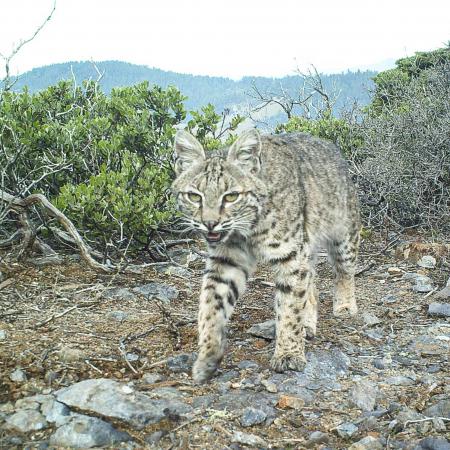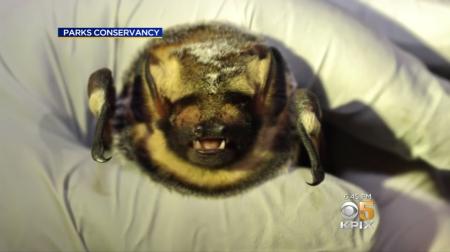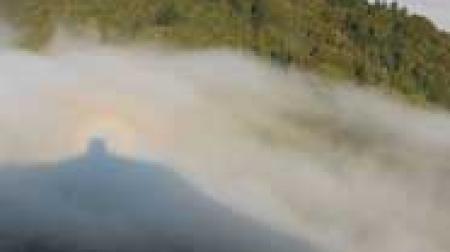Why Was This Indicator Chosen?
Mammals are good indicators of ecological conditions because they are responsive to habitat change (Andren, 1994) and landscape connectivity, and play important roles in the food web as both predators and prey. Mammals’ high energetic demands require habitats that support suitable prey bases.
In 2014, One Tam began a community science effort using motion-activated cameras to better understand how mammals are doing, Marin Wildlife Watch (formerly called the Marin Wildlife Picture Index Project). The results shown here are based on the first three years of data, 2014-2017. With the continued dedication of our volunteers and now with the help of cloud-based AI platform Wildlife Insights, we look forward to being able to process more data more quickly and continue to build the picture of mammal community health.
What is Healthy?
The desired condition for the mammalian community within the study area (which extends beyond the One Tam area of focus to the north) is to maintain and, where able, improve native biodiversity, abundance, and the habitats that support this community. More specifically, this entails the following:
- The full suite of expected native mammals is present.
- Native species diversity is high and stable (or increasing); mammals are well represented across trophic levels and are distributed across the landscape.
- Rare species are present within our study area and, ideally, are detected by both North and South Array cameras. Increasing occupancy by these rare species is also desired.
- Non-native mammals, especially species such as feral pigs (Sus scrofa) that have large ecosystem impacts, are not present.
- Wildlife habitat is protected or enhanced through actions such as maintaining patch sizes of diverse habitat types and landscape connectivity. (Note: Habitats and patch-size needs will differ by species.)
What Are the Biggest Threats?
- The lingering effects of historical impacts including land use changes, hunting, and trapping
- Habitat loss and fragmentation, which can be particularly detrimental to species such as mountain lions that require large home ranges
- Disease, including those spread by contact with pets
- Rodenticide and pesticide exposure, especially for mammals that live near residential areas
- Visitor use, which can affect the abundance and behavior of mammal communities (George & Crooks, 2006; Reed and Mehrlander, 2008; Lenth et al., 2008)
- Invasive plant species that alter wildlife habitat, and invasive animals that outcompete native species for food, water, nest or burrow sites, and shelter
- The potential for more intense wildfire due to climate change and past fire suppression may be a threat to mammals
What is The Current Condition?
Overall, mammals are in good condition, with a steady trend. The four metrics used in this assessment included native species richness, which remained in good condition with an improving trend. In 2022, we were able to calculate a metric for species occupancy estimates and the Wildlife Picture Index (a way of using wildlife camera data to measure biodiversity trends). Species-specific abundance and stability were rated as good, and the Wildlife Picture Index was rated as caution. Our rare species metric moved from a condition of significant concern to good. Invasive species remained in good condition with no change in trend in 2022. We were also able to add two new native species to this update: the long-tailed weasel (Mustela frenata) and the American black bear (Ursus americanus). Note that because we had only limited Marin Wildlife Watch camera data for badgers, we decided to drop that chapter from this 2022 update, instead including them as a rare species in this overall mammal chapter.
What is the Current Trend?
The trend is No Change.
How Sure Are We?
Our certainty in these conclusions is currently Moderate. In 2016, we had access to a limited amount of wildlife camera data. Since then, we have increased both the number of wildlife cameras and the areas they cover. These data have allowed for additional analysis in this update—in particular, Metric 3: Wildlife Picture Index—for key groups. More years of data as our Marin Wildlife Watch program continues may increase our confidence.
What is This Assessment Based On?
Data from remote cameras installed in 2014 and from additional cameras installed in 2017 as a part of Marin Wildlife Watch have allowed us to consider a suite of native and non-native mammals and thus provide a more complete picture of how terrestrial ecosystems on Mt. Tam are doing. At the time of the 2016 report, the cameras had only been in place for two years and much of the data that had been collected had not yet been processed. For the 2022 update, we were able to use three years of data (2014–2017) from our North Array, and three seasons (summer, fall, and winter, 2017) in our South Array. More data and wider camera coverage around Mt. Tam increased our understanding of the mammal community as well as our confidence in our assessment of their condition and trend.
What Don’t We Know?
Key information gaps include:
- The effects of climate change on mammal habitats on Mt. Tam
- Numbers and distribution of small mammals, as Marin Wildlife Watch cameras most reliably capture mid- to large-size animals (those over 1 kg)
resources
Ahumada, J. A., Silva, C. E. F., Gajapersad, K., Hallam, C., Hurtado, J., Martin, E., McWilliam, A., Mugerwa, B., O’Brien, T., Rovero, F., Sheil, D., Spironello, W. R., Winarni, N., & Andelman, S. J. (2011). Community structure and diversity of tropical forest mammals: Data from a global camera trap network. Philosophical Transactions of the Royal Society, Biological Sciences, 366(1578), 2703–2711. https://doi.org/10.1098/rstb.2011.0115
Andren, H. (1994) Effects of habitat fragmentation on birds and mammals in landscapes with different proportions of suitable habitat: A review. Oikos, 71(3), 355–366. https://doi.org/10.2307/3545823
Buckland, S. T., Magurran, A. E., Green, R. E., & Fewster, R. M. (2005). Monitoring change in biodiversity through composite indices. Philosophical Transactions of the Royal Society, Biological Sciences, 360(1454), 243–254. https://doi.org/10.1098/rstb.2004.1589
Crooks, K. R., & Soulé, M. E. (1999) Mesopredator release and avifaunal extinctions in a fragmented system. Nature, 400, 563–566. https://doi.org/10.1038/23028
Edson, E., Farrell, S., Fish, A., Gardali, T., Klein, J., Kuhn, W., Merkle, W., O’Herron, M., & Williams, A. (Eds.). (2016). Measuring the health of a mountain: A report on Mount Tamalpais’ natural resources. https://www.onetam.org/media/pdfs/peak-health-white-paper-2016.pdf
Evens, J. (1983). Natural history of the Point Reyes peninsula. University of California Press.
Fellers, G. M., & Pratt, D. (2002). Terrestrial vertebrate inventory, Point Reyes National Seashore, 1998–2001 [Report]. National Park Service. https://irma.nps.gov/DataStore/DownloadFile/152978
Fifield, V. L., Rossi, A. J., & Boydston, E. E. (2015). Documentation of mountain lions in Marin County, California, 2010–2013. California Fish and Game, 101(1), 66–71. https://pubs.er.usgs.gov/publication/70148574
Furnas, B. J., Landers, R.H., Paiste, R. G., & Sacks, B. N. (2020). Overabundance of black-tailed deer in urbanized coastal California. The Journal of Wildlife Management, 84(5), 979–988. https://doi.org/10.1002/jwmg.21849
Gaston, K. J., Blackburn, T. M., Greenwood, J. J. D., Gregory, R. D., Quinn, R. M., & Lawton, J. H. (2000). Abundance-occupancy relationships. Journal of Applied Ecology, 37(Suppl. 1), 39–59.https://www.jstor.org/stable/2655767
George, S. L., & Crooks, K. R. (2006). Recreation and large mammal activity in an urban nature reserve. Biological Conservation, 133(1), 107–117. https://doi.org/10.1016/j.biocon.2006.05.024
Howell, J. A., Ettlinger, E., Semenoff-Irving, M., & Stout, S. (1998). Muir Woods inventory of sensitive species in old-growth forest: Mammalian inventory summer 1997, winter 1998 [Report]. Western Ecological Research Center.
Johnston, A. N. (2013). Eastern gray squirrel ecology and interactions with western gray squirrels [Unpublished doctoral dissertation]. University of Washington. http://hdl.handle.net/1773/22917
Lenth, B. E., Knight, R. L., & Brennan, M. E. (2008). The effects of dogs on wildlife communities. Natural Areas Journal, 28(3), 218–227. https://doi.org/10.3375/0885-8608(2008)28[218:TEODOW]2.0.CO;2
Muchlinski, A. E., & King, J. L. (2010). Documentation of replacement of native western gray squirrels by introduced eastern fox squirrels. Bulletin, Southern California Academy of Sciences, 108(3), 160–162. https://doi.org/10.3160/0038-3872-108.3.160
O’Brien, T. (2010). Wildlife picture index: Implementation manual (Ver. 1.0; WCS working paper no. 39). Wildlife Conservation Society. https://library.wcs.org/en-us/doi/ctl/view/mid/33065/pubid/DMX3099400000.aspx
O’Brien, T. G., Baillie, J. E. M., Krueger, L., & Cuke, M. (2010). The wildlife picture index: Monitoring top trophic levels. Animal Conservation, 13(4), 335–343. https://doi.org/10.1111/j.1469-1795.2010.00357.x
Reed, S. E., & Merenlender, A. M. (2011). Effects of management of domestic dogs and recreation on carnivores in protected areas in northern California. Conservation Biology, 25(3), 504–513. https://ucanr.edu/sites/merenlender/files/132615.pdf
Reilly, M. L., Tobler, M. W., Sonderegger, D. L., & Beier, P. (2017). Spatial and temporal response of wildlife to recreational activities in the San Francisco Bay ecoregion. Biological Conservation, 207, 117–126. https://www.sciencedirect.com/science/article/pii/S0006320716307327
Riley, S. P. D., Bromley, C., Poppenga, R., Uzal, F. A., Whited, L., & Sauvajot, R. M. (2007). Anticoagulant exposure and notoedric mange in bobcats and mountain lions in urban southern California. Journal of Wildlife Management, 71(6), 1874–1884. https://doi.org/10.2193/2005-615
Riley, S. P. D., Foley, J., & Chomel, B. (2004). Exposure to feline and canine pathogens in bobcats and gray foxes in urban and rural zones of a national park in California. Journal of Wildlife Diseases, 40(1), 11–22. https://tinyurl.com/2p935uzz
Semenoff-Irving, M., & Howell, J. A. (2005). Pilot inventory of mammals, reptiles, and amphibians, Golden Gate National Recreation Area, California, 1990–1997 (Open-File Report 2005-1381). U.S. Geological Survey. https://doi.org/10.3133/ofr20051381
Townsend, S. E. (2015). The Marin wildlife picture index project: Pilot for monitoring wildlife in Marin County: Interim analysis (Final administrative draft). Marin County Parks, Marin Municipal Water District, Samuel P. Taylor State Park, Golden Gate National Recreation Area.
Townsend, S. E. (2018). The Marin wildlife picture index project: Diversity, occupancy and trends in biodiversity, fall 2014–summer 2017 (Administrative draft). Golden Gate National Parks Conservancy.
Townsend, S. E. (2020). The Marin wildlife picture index project: North and south array, summer 2017 (Preliminary draft). Golden Gate National Parks Conservancy.
Townsend, S. E., Hammerich, S., & Halbur, M. (2020). Wildlife occupancy and trail use before and after a park opens to the public. California Fish and Wildlife Journal [Special Issue: Recreation], 74–94. https://nrm.dfg.ca.gov/FileHandler.ashx?DocumentID=178943&inline
Trouwborst, A., McCormack, P. C., & Martinez, C. E. (2020). Domestic cats and their impacts on biodiversity: A blind spot in the application of nature conservation law. People and Nature, 2(1), 235–250. https://doi.org/10.1002/pan3.10073




